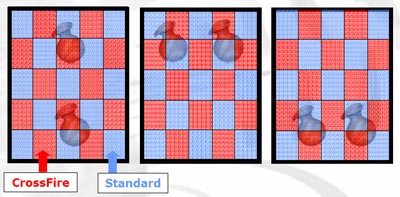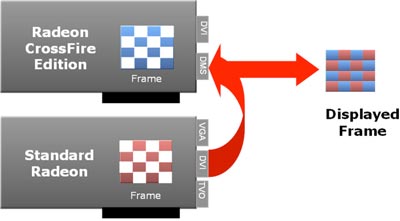CROSSFIRE vs SLI
2. Rendering Modes
Review Pages
Crossfire on the other hand, offers 4 kinds of rendering modes: AFR, Supertile, Scissor and SuperAA.

AFR works by rendering all odd frames with one GPU while all even are left to the other. The method is exactly the same as AFR used by NVidia. The main problem with this method is that if a frame contains data that affects the rendering of the next frame to come, then that data needs to be transferred between the two cards. This overhead is why AFR is not so popular.

Scissor is also similar to NVidia's SFR with a small difference. Each frame is split in two parts and each GPU is assigned with a portion to render. That way, the GPUs can share the number of triangles processed in a scene, reducing their time to present us with the final rendered frame. Scissor can cut the screen in two parts, either horizontal or vertical, (SLI can only split the screen horizontally) and can also adjust the split to be uneven if in one of the two parts the scene gets more complicated than the other.

This is where ATi comes in with its novel method, Supertile. Their idea was to efficiently share the workload among the GPUs without spending time on calculating the GPU workload. Supertile is the default rendering option for Crossfire enabled systems but you'll also be able to pick your preferred method from the ATi Catalyst driver menu.

Supertile splits each frame into small tiles, just 32px by 32px in size and alternates their assignment to the GPUs just like a checkerboard. ATi has found that splitting the screen this way does not overload one GPU over another, as screen objects are usually much larger than the tiles and thus are split in two or more adjacent tiles.

Review Pages





















